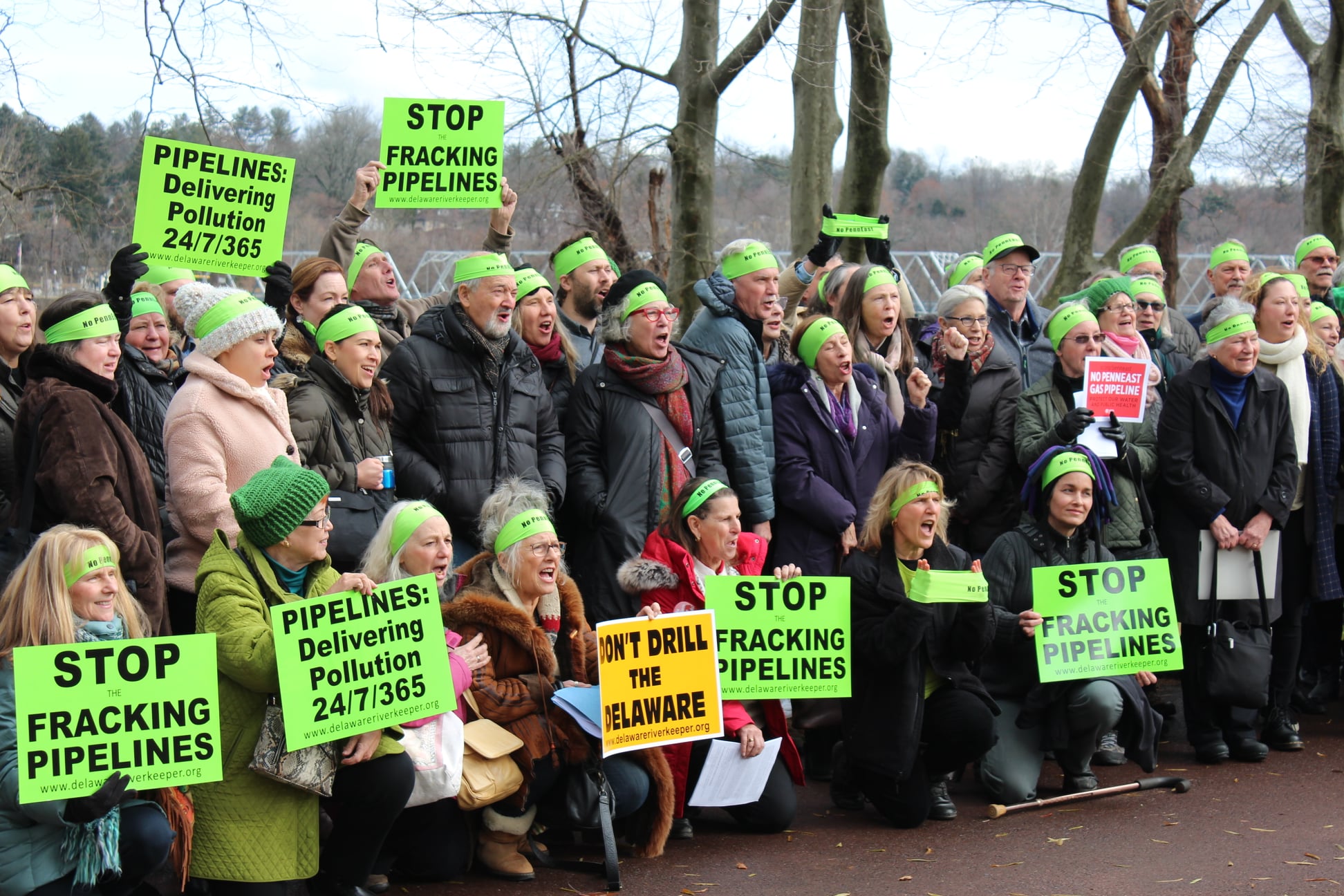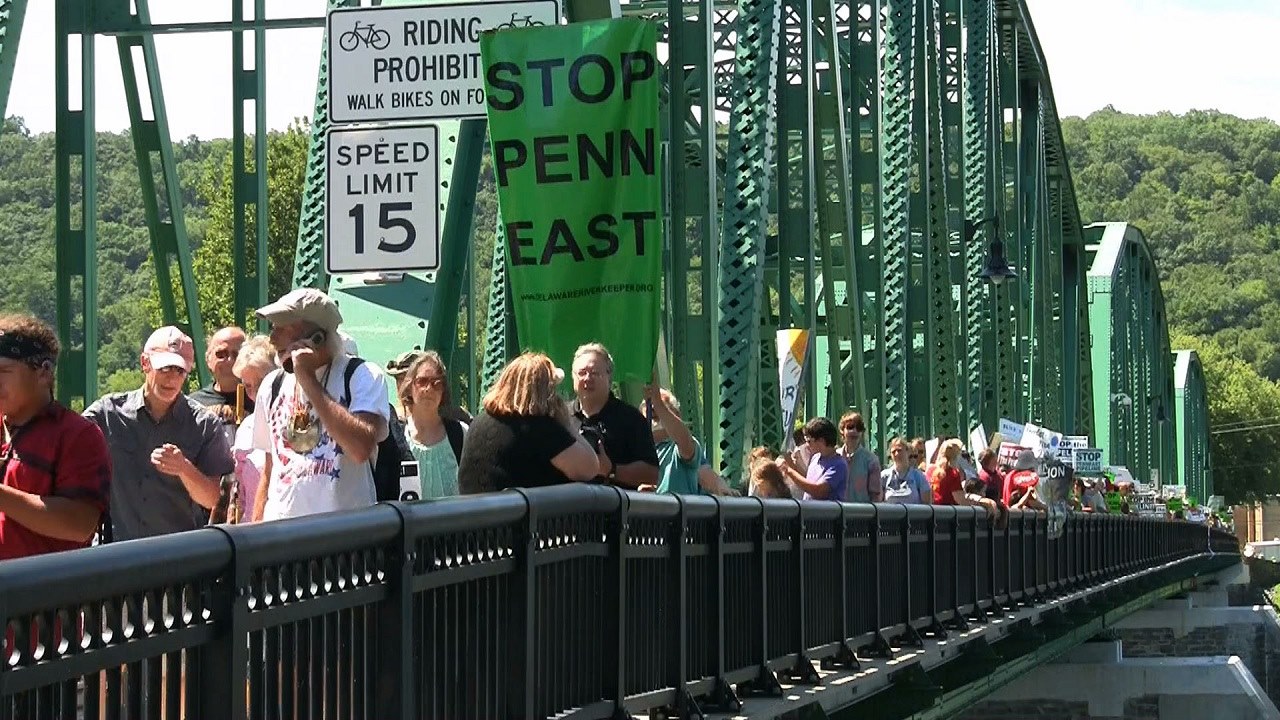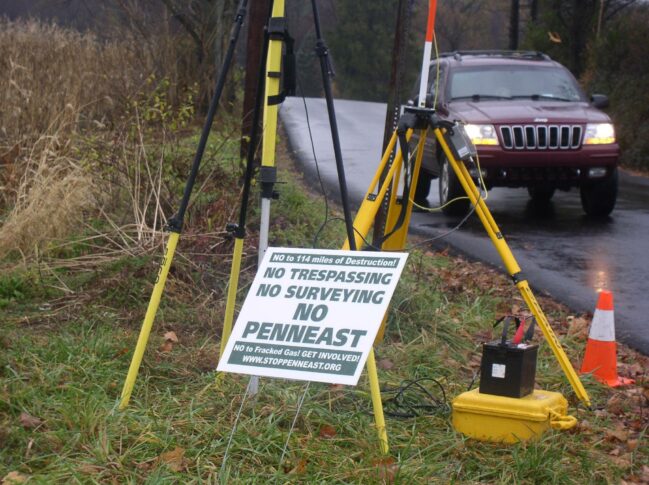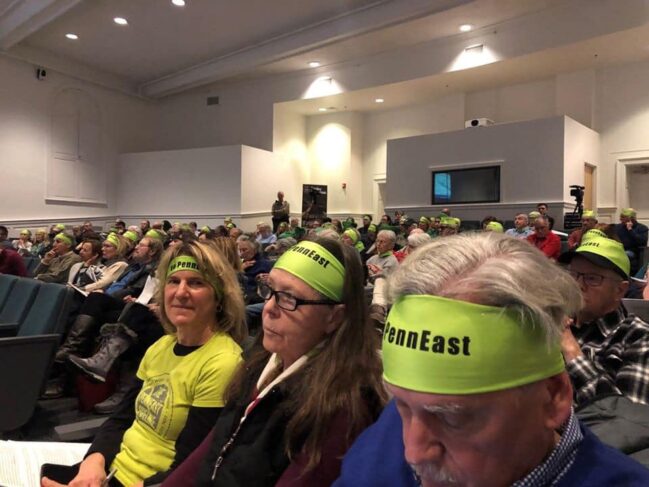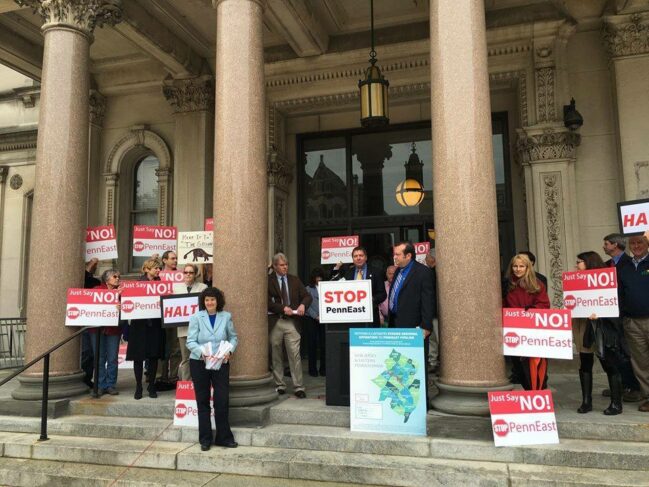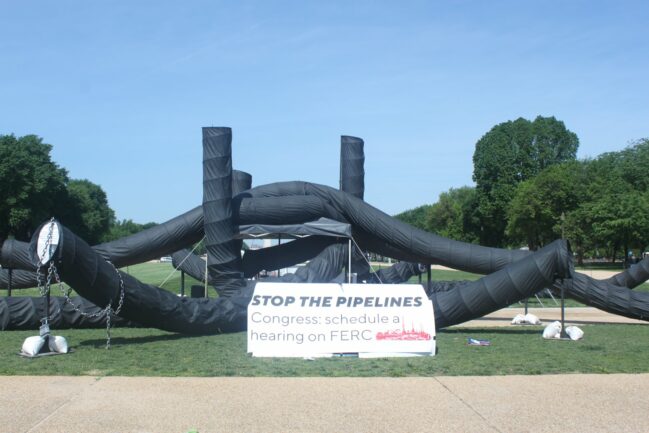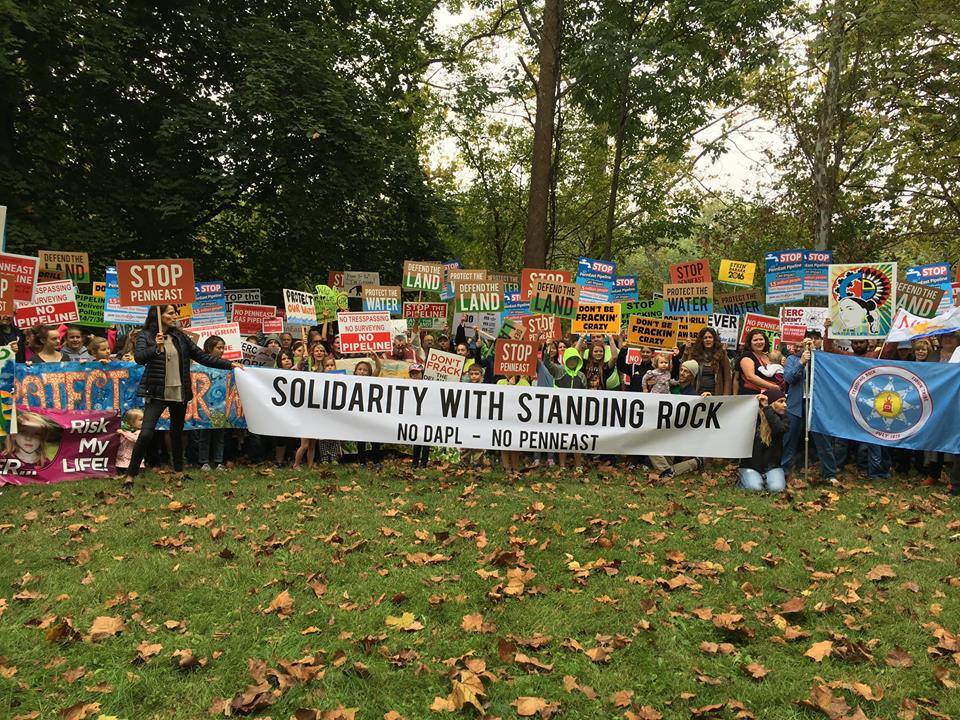UPDATE: On September 27, 2021, PennEast announced it would abandon the pipeline project, citing primarily a lack of outstanding permits — including necessary Clean Water Act-related permits for Pennsylvania and New Jersey; and permits from the Delaware River Basin Commission and U.S. Army Corps of Engineers. [source]
The proposed PennEast Pipeline — a consortium between Enbridge (formerly Spectra Energy) Southern Company, UGI Corp., New Jersey Resources, and South Jersey Industries — would transport fracked gas produced in the northeast Pennsylvania Marcellus shale to the Texas Eastern Transmission and Algonquin Gas Transmission systems in New Jersey. Construction would be expected to take 7 months if permits are obtained for the project’s new chosen path forward — separating the permitting for segments in Pennsylvania and New Jersey, after permits in N.J. were rejected by state agencies.
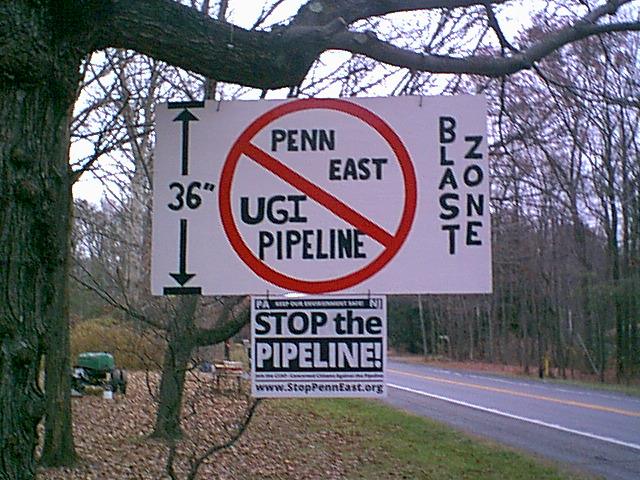
Bill Kellner constructed & posted the sign on his property on Rte. 209 in Towamensing. The Penn East projected blast zone for a 36 inch pipe under 1480 psi is 900 ft in all directions. (Photo: Stop The Fracking Pipeline-A Project of Save Carbon County)
The pipeline’s crossing near Riegelsville, N.J. would be within the Lower Delaware National Scenic and Recreational River. Near its southern terminus, the pipeline would cut through the Sourland Mountain, which contains the last contiguous forested areas in central New Jersey and has been recognized as a unique and fragile ecosystem. From its origin in Luzerne County, Pennsylvania, to its destination in Mercer County, New Jersey, the pipeline would cross more than 88 waterways, 44 wetlands, 30 parks, and 33 conservation easements. In New Jersey, 6 streams carrying the Category 1 designation for their exceptional ecological significance, will be crossed, some more than once. [source]
A case currently before the U.S. Supreme Court will have significant implications for both the PennEast project and other corporations seeking to use the power of eminent domain to obtain state-owned land for their projects — such as Columbia Transmission’s similarly-stymied Eastern Panhandle Expansion Project. Previously, the 3rd US Circuit Court of Appeals ruled against PennEast, citing states’ sovereign immunity. In March 2021, the Biden administration affirmed the position of the Trump administration in the case, arguing that PennEast was under its authority under the Natural Gas Act to seize the state-owned property.
The ruling could affect the estimated 1,200 miles of new natural gas pipeline planned every year until 2035. Oral arguments in the case were heard at the U.S. Supreme Court on April 28, 2021.
In June 2021, the U.S. Supreme Court sided with PennEast, and overturned an earlier ruling that said PennEast Pipeline could not use eminent domain to build its pipeline, clearing the way for condemnation of state land for the pipeline and establishing a troubling new precedent for property rights.
However, despite this victory at the Supreme Court, in September 2021, PennEast announced it would abandon the project, with a lack of outstanding permits cited — including necessary Clean Water Act-related permits for Pennsylvania and New Jersey; and permits from the Delaware River Basin Commission and U.S. Army Corps of Engineers.
Recent Media Coverage
- (Sept. 27, 2021): Delaware Riverkeeper Network: IT’S OVER! PENNEAST IS DONE!
- (Sept. 27, 2021): Reuters: PennEast becomes the latest to scuttle a natural gas pipeline project
- (Sept. 27, 2021): ROI-NJ: Gov. Murphy thrilled PennEast project proposal is being dropped: ‘It would have wrecked our state’
- (June 29, 2021): WHYY: U.S. Supreme Court rules PennEast pipeline project can use eminent domain to take N.J. state land
- (April 29, 2021): NJ Spotlight: PennEast will scrap pipeline if it loses U.S. Supreme Court appeal
- (April 25, 2021): National Law Review: Supreme Court to Hear Arguments Regarding Natural Gas Act and Eminent Domain Power
- (March 10, 2021): E&E News: Biden echoes Trump in Supreme Court eminent domain battle
- (Feb. 10, 2021): SCOTUSblog: PennEast Pipeline Co. v. New Jersey
- (Dec. 26, 2020): Lehigh Valley Live: PennEast Pipeline’s route into Northampton County is focus of state hearing
Project Details
- Owner: Enbridge (Spectra Energy, 20.00%), Southern Company (20.00%), UGI Corporation (UGI) (20.00%), New Jersey Resources (20.00%), South Jersey Industries (20.00%)
- Capacity: 1,107 million cubic feet per day
- Length: 118 miles: Luzerne, PA > Pennington, NJ (MAP)
- Diameter: Mostly 36-inches
- Cost: US$ 1.2 billion
- Status: Proposed
- Start Year: 2022 (Pennsylvania), 2024 (New Jersey)
- Project backers:
- NJR Pipeline Co., PSEG PowerSJI Midstream, AGL Resources, Spectra Energy Partners, UGI Energy Services [source]
- November 2020: New Jersey Natural Gas pulls support for the PennEast Pipeline Project, quarterly report indicates it has “No reliance on PennEast completion to achieve growth objectives.” [source]
Project Status
Eminent Domain:
-
June 2021: The U.S. Supreme Court sides with PennEast, clearing the way for condemnation of state land for the pipeline and establishing a troubling new precedent for property rights. [source]
- April 28, 2021: U.S. Supreme Court hears oral arguments on PennEast eminent domain challenge [source]
- February 2021: U.S. Supreme Court agrees to hear arguments on PennEast Pipeline’s appeal seeking to overturn a decision from the 3rd U.S. Circuit Court of Appeals that blocks it from seizing New Jersey state land via eminent domain. [source]
- September 2019: United States Court of Appeals for the Third Circuit blocks PennEast Pipeline’s to condemn state-owned lands via eminent domain, reversing lower court decision allowing the company to condemn 131 properties, including over 40 owned by the state that had been previously preserved for agricultural, recreational or conservation purposes [source]
- February 2018: PennEast commences almost 200 eminent domain actions in U.S. District Courts in New Jersey and Pennsylvania. [source]
- January 2018: FERC Certificate of Public Convenience and Necessity granted
Indigenous Free, Prior & Informed Consent; Consultation & Environmental Justice:
- No free, prior & informed consent. Free, Prior and Informed Consent (FPIC) is a specific right that pertains to Indigenous peoples and is recognized in the United Nations Declaration on the Rights of Indigenous Peoples (UNDRIP). It allows them to give or withhold consent to a project that may affect them or their territories. Once they have given their consent, they can withdraw it at any stage. Furthermore, FPIC enables them to negotiate the conditions under which the project will be designed, implemented, monitored and evaluated. This is also embedded within the universal right to self-determination. [source]
Outstanding Permits:
-
January 2021: Public hearing for NJ Dept of Environmental Protection 105, 102 permit applications. (Public comments closed Jan 20.) [source]
- January 2021: FERC tables consideration of PennEast Pipeline’s revised application for a two-phase construction in PA and NJ.
- August 2020: FERC approves re-submitted PennEast application for two-phase project, does not find environmental issues
- February 2020: PennEast submits new application with FERC to split the pipeline project into two “phases,” with one phase comprising the majority of pipe in Pennsylvania, and the second phase including the majority of pipe in New Jersey.
- October 8, 2019: New Jersey Dept. of Environmental Protection denies PennEast applications for a state Freshwater Wetlands Act permit, a Flood Hazard Area Verification and Letter of Interpretation, and a Clean Water Act Section 401 Certification without prejudice (leaving the door open for PennEast to re-file if they so chose) [source]
- August 2019: PennEast submits a renewed application to New Jersey Dept. of Environmental Protection for a state Freshwater Wetlands Act permit, a Flood Hazard Area Verification and Letter of Interpretation, and a Clean Water Act Section 401 Certification. [source]
- May 2018: FERC denies requests for rehearing of PennEast permit certificate from DRN et al.
-
February 2018: Delaware Riverkeeper Network petitions the Delaware River Basin Commission (DRBC) to exercise its authority in the Delaware River Basin; ensure a nonpoint source pollution control plan is secured, reviewed, and approved for Penneast prior to approval of a DRBC docket; and ensure the DRBC will prevent construction on any part of the Penneast pipeline until Commissioner approval of a DRBC docket for the project. [source]
- January 2018: FERC Certificate of Public Convenience and Necessity granted
- June 2017: New Jersey Department of Environmental Protection rejects Water Quality Permit — effectively stopping the project in N.J.
Impact Litigation / Court Fights:
- Federal Court:
-
July 2021: The U.S. Supreme Court sides with PennEast, clearing the way for condemnation of state land for the pipeline and establishing a troubling new precedent for property rights. [source]
- April 28, 2021: U.S. Supreme Court hears oral arguments on PennEast eminent domain challenge [source]
- February 2021: U.S. Supreme Court agrees to hear arguments on PennEast Pipeline’s appeal seeking to overturn a decision from the 3rd U.S. Circuit Court of Appeals that blocks it from seizing New Jersey state land via eminent domain. [source]
- September 2019: United States Court of Appeals for the Third Circuit blocks PennEast Pipeline’s to condemn state-owned lands via eminent domain, reversing lower court decision allowing the company to condemn 131 properties, including over 40 owned by the state that had been previously preserved for agricultural, recreational or conservation purposes [source]
- August 2018: Environmental groups (Delaware Riverkeeper, NJ Sierra Club, New Jersey Conservation Foundation) sue FERC over approval of PennEast, argue FERC violated both the Natural Gas Act by failing to identify the need for the project or its public benefits, and the National Environmental Policy Act by failing to consider the project’s climate effects, including that of fracking and end use. [source]
- March 2016: Delaware Riverkeeper Network files a Constitutional Challenge against the Federal Energy Regulatory Commission (FERC), arguing the Environmental Impact Statement released by FERC was biased in favor of the PennEast pipeline [source]
-
[Select information and map data excerpted from Global Energy Monitor, with permission and Creative Commons license.]


